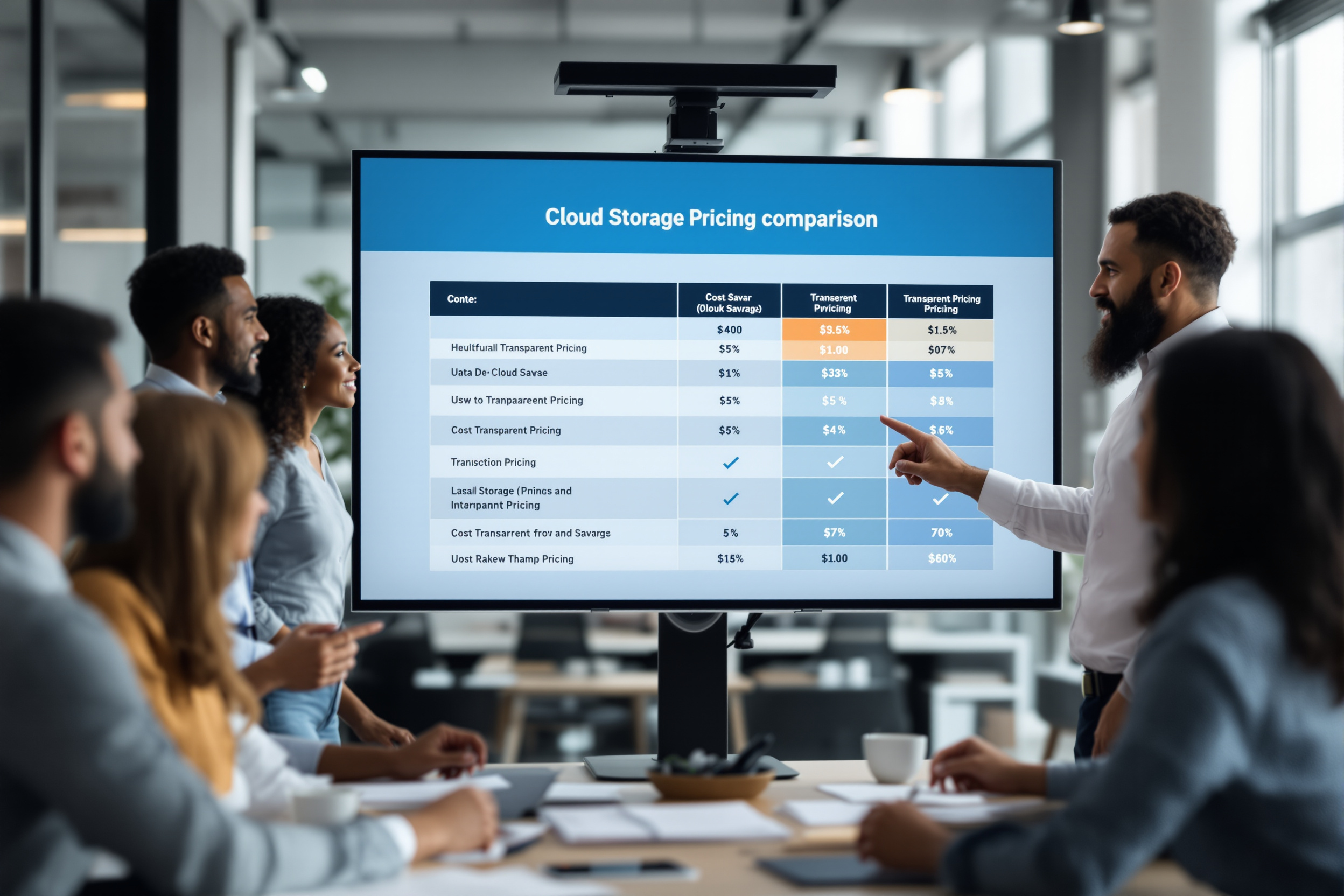Topics on this page
For most IT leaders, the best backup strategy feels out of reach due to unpredictable costs and vendor lock-in. Surprise egress fees and API charges from major providers can inflate cloud storage expenses by over 60%, making budget planning impossible. Simultaneously, ransomware attacks increasingly target backup infrastructure, making data protection a mission-critical priority. The solution is a strategy built on S3-compatible object storage with a transparent economic model. This approach provides an enterprise-ready alternative that cuts costs by up to 80% while delivering the control and security needed for 2025 and beyond.
Key Takeaways
- Eliminate unpredictable cloud costs by choosing an S3-compatible storage provider with zero egress fees, cutting expenses by 60-80%.
- The best backup strategy for 2025 requires immutable storage with Object Lock to provide absolute protection against ransomware attacks.
- Full S3 API compatibility ensures you can migrate to a new storage platform without rewriting code, protecting existing investments in tools and scripts.
Eliminate the #1 Cloud Pain Point: Unpredictable Costs
Most enterprises struggle with surprise cloud storage bills. Unplanned egress charges alone account for an average of 6% of an organization's total cloud storage costs. These fees apply any time data moves out of a provider's network, even to another availability zone.
This cost unpredictability is the top cloud pain point for IT leaders. Relying on a single provider creates vendor lock-in, making a switch prohibitively expensive. A better data backup plan is essential for financial control.
Organizations report 60-80% cost savings by eliminating egress fees from backup workflows. This shift allows for predictable budgeting and a clear ROI calculation. A transparent model with zero egress or API fees is the foundation of a modern, cost-efficient strategy.
Build a Resilient Strategy on S3 Compatibility
The best backup strategy for any enterprise starts with open standards. The S3 API has become the de-facto standard for object storage, ensuring broad tool compatibility. This allows you to migrate from a legacy provider without rewriting a single line of application code.
An effective strategy involves several key steps. First, you must identify all critical data that requires protection across the business. Then, you can choose a solution that fits your operational and compliance needs. A fully S3-compatible platform protects your past investments in scripts and tools.
This approach provides a built-in exit strategy. With S3 compatibility and no egress fees, you break free from vendor lock-in. This preserves your negotiation power and gives you long-term freedom of action for your cloud backup solutions.
Fortify Your Defenses with Immutable Storage
Ransomware attacks are becoming a primary threat to business continuity. Backups are the main target, making their protection a non-negotiable requirement. The best backup strategy must include a robust defense against these evolving cyber threats.
Immutable storage with Object Lock is the definitive solution. It makes backup data fixed and unchangeable, so it cannot be encrypted or deleted by ransomware. This guarantees a clean recovery point for your disaster recovery plan. A recent survey found that 94% of IT leaders now rely on immutable storage for protection.
Implementing this technology is a core part of modern data resilience. An immutable backup ensures you can restore operations without paying a ransom. It also helps meet stringent compliance requirements for data retention and integrity.
Demand an Enterprise-Ready Architecture
Not all S3-compatible storage is built for enterprise workloads. A truly enterprise-ready platform delivers consistent performance and availability without hidden costs. It provides an "Always-Hot" object storage model where all data is immediately accessible.
This architecture eliminates fragile tiering policies that cause restore delays and API timeouts. It can deliver up to 20% faster backup performance with consistent low latency. An effective platform should include these key features:
- Full S3 API compatibility for advanced features like versioning and lifecycle management.
- Strong read/write consistency for mixed workloads with millions of small files.
- Multi-layer encryption for data in transit and at rest.
- Granular IAM with MFA, RBAC, and support for SAML/OIDC.
- Enterprise-grade certifications, including SOC 2 and ISO 27001.
This design simplifies operations and keeps third-party tools like Veeam backup stable and predictable. It ensures your data is always ready for recovery when you need it most.
Empower MSPs with a Partner-Ready Platform
For Managed Service Providers, predictable margins are essential for growth. The best backup strategy for the channel is one that eliminates surprise costs entirely. A platform with zero egress or API fees allows MSPs to quote BaaS and DRaaS offerings with confidence.
A partner-ready console simplifies management and accelerates onboarding. With out-of-the-box integrations for tools like NovaBackup and Acronis Cyber Protect, partners can onboard new clients in under 60 minutes. This capability accelerates time-to-revenue significantly.
A purpose-built MSP platform should deliver:
- A multi-tenant console with robust role-based access control (RBAC).
- Full automation capabilities via a comprehensive API and CLI.
- Integrated reporting to track usage and margins.
- A predictable economic model that removes all hidden fees.
This model turns cost efficiency into a powerful competitive advantage for partners.
Follow a 3-Step Path to a Better Backup Strategy
Migrating to a cost-efficient and secure platform is a straightforward process. The best backup strategy is one that is easy to implement and manage. Following a proven framework like the 3-2-1 backup rule provides a solid foundation.
You can transition your backups in just three steps:
- Configure Your Tools: Simply change the endpoint in your existing S3-compatible backup software to the new storage platform.
- Update Credentials: Swap in the new access keys and security credentials while keeping all your backup jobs and scripts intact.
- Test and Verify: Run a test backup and, more importantly, a test restore to confirm everything works as expected and data is recoverable.
This simple migration path minimizes risk and protects your past investments. It allows you to start realizing cost savings of 60-80% almost immediately. To begin building your best ransomware protection strategy, talk to an expert today.
More Links
Federal Statistical Office of Germany presents tables and data related to the use of information and communication technology (ICT), specifically cloud computing, in German companies.
Bitkom reports on the German economy's demand for a German cloud solution, emphasizing data security and sovereignty.
Statista provides market outlook data and forecasts for the public cloud market in Germany, including revenue and user statistics.
German Institute for Economic Research explores how cloud solutions can increase productivity, likely focusing on the German economy.
Munich Chamber of Industry and Commerce offers advice on securing data within the context of digitalization and information security.
Cloudflare addresses the challenge of cloud egress fees and their impact on the future of artificial intelligence.
FAQ
What is the best backup strategy for a modern enterprise?
The best strategy combines a proven methodology like the 3-2-1 rule with modern technology. This includes using S3-compatible object storage to avoid vendor lock-in, implementing immutable backups with Object Lock for ransomware protection, and choosing a provider with a predictable cost model that has zero egress or API fees to ensure cost efficiency.
How much can I save by switching to a storage provider with no egress fees?
Organizations typically report savings of 60-80% on their total cloud storage costs. These savings come from eliminating unpredictable egress fees and API call charges, which often constitute the largest portion of a cloud bill for backup and archive workloads.
Is it difficult to migrate my existing backups to an S3-compatible alternative?
No, the migration process is designed to be simple. Because the platform is fully S3-compatible, you only need to update the endpoint and credentials in your existing backup software. Your applications, scripts, and backup jobs will continue to work without any code changes.
What is 'Always-Hot' storage and how does it benefit backups?
Always-Hot storage means all your data is immediately accessible without any delays or restore fees associated with retrieving data from colder, archived tiers. This simplifies operations, ensures fast recovery times (RTOs), and improves the performance of your backup and restore processes by up to 20%.
What compliance certifications should I look for in a backup storage provider?
For enterprise-grade workloads, especially in regulated industries, look for providers with key certifications like SOC 2 and ISO 27001. These certifications verify that the provider meets high standards for security, availability, processing integrity, confidentiality, and privacy.
How does a predictable cost model help Managed Service Providers (MSPs)?
A predictable model with no egress or API fees allows MSPs to build profitable Backup-as-a-Service (BaaS) and Disaster-Recovery-as-a-Service (DRaaS) offerings. It eliminates surprise costs that erode margins, enabling MSPs to provide competitive pricing to clients while maintaining profitability.



.png)
.png)
.png)
.png)



.png)




%201.png)